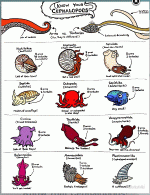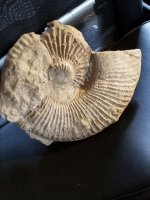lpetrich
Contributor
The Cephalopoda - at the University of California Museum of Paleontology
Cephalopoda - at the Tree of Life web project
Cephalopods ("head foot") are mollusks, relatives of snails and clams. They have several highly flexible limbs, called arms or tentacles. A tentacle, in the general sense, is a limb that is flexible along its length, and not just at joints, and in that sense, every cephalopod limb is a tentacle.
But there is a complication. Squid and cuttlefish have eight short limbs and two long limbs. But there is a convention in squid anatomy of calling the short tentacles arms and the long tentacles plain tentacles. This convention is often extrapolated to octopuses, making their eight limbs arms instead of tentacles. This convention is also often extrapolated to the extinct belemnoids, making their ten limbs arms instead of tentacles.
But octopus limbs are still tentacles in a general sense, even if not in a squid-anatomy sense. And squid arms are also still tentacles in a general sense.





